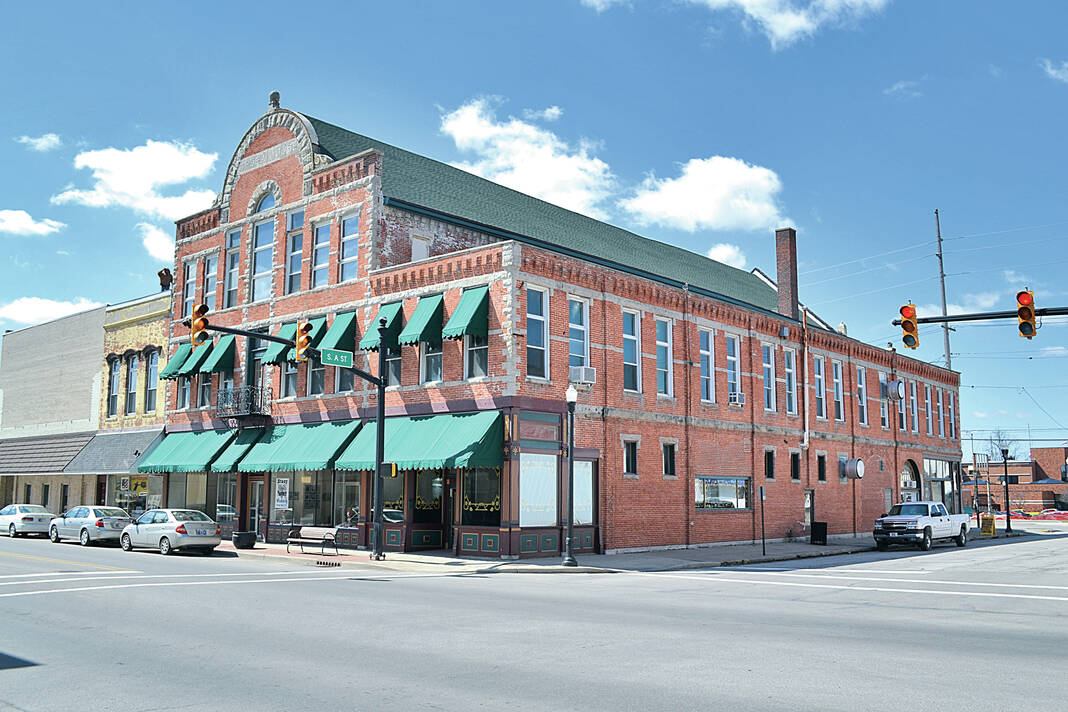
Elwood Opera House
Submitted photo

By Stephen Jackson | For The Times-Post
Buzzardsville is one of those place names in Madison County that for years has eluded those who sought to know its location.
How it got its name is a complete mystery unless one speculates that it was a place where large birds of prey such as hawks and North American vultures made their habitat.
It appears on only two county maps: One in 1853 on a road leading from New Madison, and the other in 1864.
It was situated alongside the old Pan Handle Railroad to the southeast of present-day Elwood at the point where today’s South P Street crosses the old railroad grade.
This area would have been well outside the town limits in 1853 and in a more rural setting, suggesting the possibility of a wilderness area conducive to a bird habitat.
However, there is another explanation for the area’s name that is reflective of another definition of the word buzzard, that being a cantankerous person, or in the case of Buzzardsville, perhaps area residents.
Which definition best described the area? We will probably never know!
The Indiana General Assembly in 1821 provided for the construction of two dozen state roads, many connecting to the new location for the state capital at Indianapolis.
One of these was to be a stage coach road from Indianapolis to Fort Wayne.
Construction was started in 1825 and completed three years later by companies operating out of both towns.
The road was heavily traveled and lasted until long after the Civil War.
The trace left Indianapolis in a northeasterly direction and crossed the West Fork of White River at a ford east of the deserted Indian village at Strawtown.
It was hardly a road in a modern sense but merely a trace that wound around the large virgin trees that were numerous in our area.
The small trees and brush were cleared to about a 12-foot width close to the ground to allow for stage coach axle clearance.
When possible, the course followed the ridges and higher ground, aiming for the river fords and utilizing old Indian trails that were numerous in this area.
The trace entered Madison County slightly north of Perkinsville and crossed Jackson, Pipe Creek, Monroe and Van Buren townships.
It passed to the north of the old Delaware Indian village of Nancy Town on the old Strawtown road east of Perkinsville.
Pipe Creek was crossed at the ford slightly west of the Orestes road, County Road 300 West.
It skirted the Miami Reserve and left Madison County near the northeast corner of Van Buren Township.
Elwood had its beginning in 1852, when William Barton opened a general store.
The store was located immediately east of where the City Building now stands.
On March 1, 1853, a town was platted by James Anderson, J.B. Frazer and Mark Simmons and given the name Quincy by the founders.
It had one street, which ran north and south.
The reason for the choice of Quincy is unknown.
That date would have corresponded fairly closely to the establishment of the railroad from Richmond to Logansport that ran through Quincy.
Later, the LaFayette, Bloomington & Muncie Railroad arrived, intersecting with the first railroad, providing a real stimulus to the local economy and creating the need for a post office.
On Feb. 5, 1855, the post office was established.
As there was already one post office in the state located in Owen County called Quincy, the one in Madison County was named Duck Creek.
Confusion arose from having one name for the town, Quincy, and another for the post office, Duck Creek.
That continued for almost 15 years, at which point Captain F.M. Hunter, who was then postmaster, enlisted the cooperation of some of the townspeople in a movement to change the name of both the town and post office to Elwood, which occurred July 21, 1869.
A story persists as to how the name was selected.
One day in 1869 postmaster Hunter approached J.B. Frazier to tell him that Owen County already had a town named Quincy.
Duck Creek was suggested but refused because of the large duck swamp near town; the town fathers did not want the town named after a swamp.
Someone pointed to Frazier’s son and said, “Why not call it Elwood?”
In December 1872, Elwood was incorporated as a town, and was then incorporated as a city upon election results conducted April, 27, 1891.
The Elwood Opera House was truly a magnificent building, and the best part it is still with us.
Today, very little remains of its original interior appearance when it opened for business in October 1891.
Outside is a somewhat different story.
Located on the southwest corner of South A and South Anderson streets in Elwood, the front side of the three-story building retains near the top the words “OPERA HOUSE” embossed in stone, proudly proclaiming for all to see the home of the once-famous theater.
The main entrance was on Anderson Street in the center of the building, as it is today.
Immediately beyond the entrance is a stairway climbing to the second floor.
Those stairs today, although different in appearance from the 1890s, bear evidence of the wear they incurred over a century ago when they were used by theatergoers ascending them to attend the performances at the opera house on the second floor.
The theater, which could seat 850 people, was built by Gustav V. Kramer and managed by his son, J.A. Kramer.
During its 11 years of operation, Elwood Opera House played host to a variety of famous personalities from the entertainment world.
Many who performed there are memorialized today through an attractive display of photographs on the second floor, exhibited by the building’s current owner, Randall Hall.
Elwood’s population in 1892 was reported to be 4,500.
Three years later it had risen to a reported 12,000, and four years after that, in 1899, it was 14,000.
The rapid increase in population fueled by the gas boom had Gustav Kramer thinking the city would need a new opera house that could accommodate the increasing population and the accompanying growth in attendance at his opera house.
During 1902, the new Kramer Grand was constructed at the southwest corner of South B and South Anderson streets one block south of the opera house.
As spectacular as the Elwood Opera house was, the Kramer Grand was even more so.
Builder George H. Johnson erected an 1,100-seat theater that would dazzle today’s theatergoers.
The Kramer Grand opened on Thursday evening, Oct. 30, 1902.
The last show at the Elwood Opera House was on Monday, Oct. 27, 1913.
This was purposely planned so that there would be no interruption in entertainment in Elwood.
In 1907, Kramer sold the opera house to the Masons, who made it their home for the next 92 years.
For almost 17 years, the Kramer Grand enjoyed its place as Elwood’s finest theater.
But, at three in the morning of Friday, Sept. 26, 1919, a fire broke out that reduced the once-magnificent structure to ruins.
It was never rebuilt.